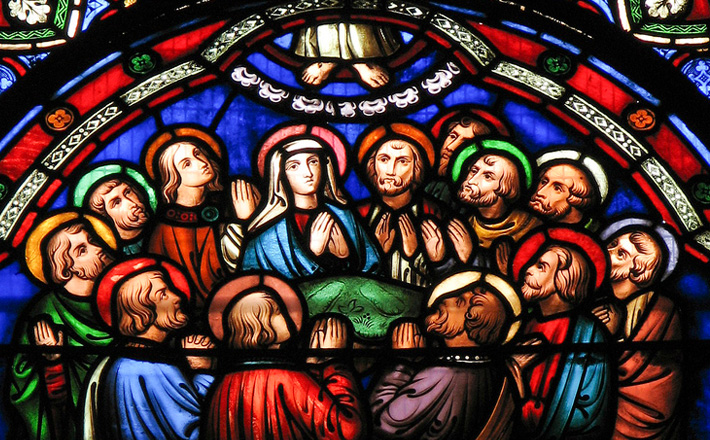Commentary on John 17:1-11
Most of you preachers out there already know this, but it never hurts to be reminded of a perhaps well-known fact because maybe this time around it will mean and preach something different.
In this case, our Gospel-comparison detail is that Jesus’ prayer to the Father before his arrest in the Gospel of John is not off alone somewhere with clutched hands praying on a big rock while the disciples nap. It is sitting around a table, after a meal and an extended conversation, with the disciples hearing every single word that Jesus says.
This aspect alone of the text for this Sunday may be all you need to get a sermon started. What difference does it make to overhear Jesus praying for you? How will you hear Jesus’ words in another way? How might we understand prayer in a new way? For those preachers drawn to these questions and moved by the thought of dwelling in the difference prayer makes, off you go, and my prayers go with you.
It really is nothing short of astonishing to imagine this passage as a model for prayer. Remember, in the Gospel of John there is no, “teach us how to pray” followed by the Lord’s Prayer. This is the Lord’s Prayer according to John. One more reminder before you get started. Don’t fall back into surface claims about why we should pray, when we should pray, or that prayer is good for us, so do it. Nobody wants to hear a sermon about the blanket benefits of prayer. Instead, preach the specificity of this prayer and maybe prayer will get a new lease on life.
It’s not often that we get a straight forward definition of eternal life, but here it is, “And this is eternal life, that they may know you, the only true God, and Jesus Christ whom you have sent.” (17:3). How many times have we heard this depiction of eternal life? I would wager rarely, if at all. On this last Sunday of Easter, in the season of the resurrection, here is an idea about eternal life that just might stand out and mean something beyond the empty tomb and the lilies and “Jesus Christ is Risen Today.”
Eternal life is to know God and Jesus. What if it is that simple? How would that change what we imagine in this life? How would it affect our thoughts about and beliefs in our future life with God? How does this alter even our picture of God? Of course, what it means to “know” God is key, and to know God in the Fourth Gospel has no connection to cognitive constructions, creedal consents, or specified knowledge about God. Rather, knowing God is synonymous with being in a relationship with God.
The preacher is invited to use the entirety of John’s Gospel to paint a picture of what being in a relationship with God looks like. In fact, the depiction should be multi-faceted and multi-sensorial, especially given the narrative of Jesus’ ministry up to this point and the Fourth Evangelist’s theological center, the incarnation. Be specific. Use the details of the stories. Don’t offer bland or general statements. The incarnation demands specificity and sensoria. At the end, the people in the pew should be able to feel, actually feel, what a relationship with God means. Let them taste it, smell it, hear it, see it. Anything less and the reality of relationship is reduced to mere acquaintance.
As the seventh and last Sunday of Easter before the festival of Pentecost and the beginning of the long, green season, Jesus’ closing words, at least in this chosen pericope, are more than a fitting finish. “And now I am no longer in the world, but they are in the world, and I am coming to you. Holy Father, protect them in your name that you have given me, so that they may be one, as we are one.” What if this blessing was that which provided a theme for the entire season of Pentecost for your congregation?
It is, perhaps, one of the most relevant and truthful definitions of what Pentecost is supposed to be as disciples of Christ. Jesus is no longer in the world. The incarnation is over. Jesus has been resurrected. He ascended to the Father from whence he came (1:1). But we are still in the world, Jesus’ works are now in our hands (14:12), and Jesus is counting on us to be his presence in the wake of his absence (21:15-17).
What if we imagined that the resurrection of Jesus was just the beginning and not the conclusion of the Gospel? That the promises of the resurrection are, in part, ours to fulfill? How would a life of discipleship, of witness, of love, between Pentecost and Advent, be different were we to trust that Jesus meant what he said in 14:12, “Very truly, I tell you, the one who believes in me will also do the works that I do and, in fact, will do greater works than these, because I am going to the Father.” We are in the world now, the world that God loves (3:16).


June 1, 2014